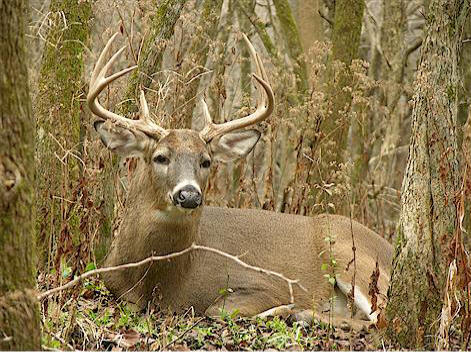
White-tailed deer are very adaptable animals, but good deer habitat usually includes a mixture of trees, shrubs, vines, forbs, grasses. High quality deer habitat will also contain important foods such as fungi and even sedges. Of course, specific plants within each of these categories benefit deer more than others. If you really looked at a deer’s mouth, you will notice that it’s quite small and relatively pointed. This is because deer are highly selective with regards to their diet.
Palatable plants should be well interspersed throughout an area, so that the whole area functions as deer habitat. Over much of the whitetail’s habitat, adequate woody plants should be present to provide food, shelter and concealment. The enroachment of woody plants into areas that were once dominated by grasses is an important reason for the expansion of the whitetail deer. In addition to browse plants, some sort of water source should be available about every mile for deer watering. Put all these habitat requirements together—food, cover, water, and space—and you’ve got whitetail habitat.
When it comes to deer habitat, plant diversity is an important because deer require a variety of plants to provide their various needs. Many plants are utilized during only one season (when they are growing/available) or a portion of a season. Keep in mind that each plant that is eaten provides only a portion of a deer’s nutritional requirements. However, many plant species are not consumed by deer. These plants are also important, serving as cover and concealment for traveling and loafing animals.
In short, deer need a variety of plants to have high-quality, year-round food and cover. Plant diversity is generally adequate where native plant communities are emphasized and managed for a variety of successional stages. This means having plant communities that range from “young” in age to “old,” or climax communities. Often times, good deer habitat is about 50% tree or woody cover and about 50% open. This interspersion of plants provides browse and forbs, which comprise the bulk of a whitetail’s diet.
I mentioned plant succession in the above paragraph, but what is it? Well, plant succession is the natural progressive change of plant species and communities on a site across time. Habitat management practices that encourage disturbances such as tilling, clearing, flooding, mowing, grazing and burning set back succession by various degrees. And trust me, deer love freshly disturbed areas because of the diversity of high quality forbs they provide.
With time, however, plant diversity in the disturbed area will decrease. Rest or lack of disturbance allows succession to progress forward toward more mature, stable plant communities. Deer need these areas as well as early successional plants, so good habitat will offer high diversity within and between plant communities.